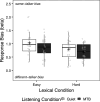Lexical effects on talker discrimination in adult cochlear implant usersa)
- PMID: 38426835
- PMCID: PMC10908561
- DOI: 10.1121/10.0025011
Lexical effects on talker discrimination in adult cochlear implant usersa)
Abstract
The lexical and phonological content of an utterance impacts the processing of talker-specific details in normal-hearing (NH) listeners. Adult cochlear implant (CI) users demonstrate difficulties in talker discrimination, particularly for same-gender talker pairs, which may alter the reliance on lexical information in talker discrimination. The current study examined the effect of lexical content on talker discrimination in 24 adult CI users. In a remote AX talker discrimination task, word pairs-produced either by the same talker (ST) or different talkers with the same (DT-SG) or mixed genders (DT-MG)-were either lexically easy (high frequency, low neighborhood density) or lexically hard (low frequency, high neighborhood density). The task was completed in quiet and multi-talker babble (MTB). Results showed an effect of lexical difficulty on talker discrimination, for same-gender talker pairs in both quiet and MTB. CI users showed greater sensitivity in quiet as well as less response bias in both quiet and MTB for lexically easy words compared to lexically hard words. These results suggest that CI users make use of lexical content in same-gender talker discrimination, providing evidence for the contribution of linguistic information to the processing of degraded talker information by adult CI users.
© 2024 Acoustical Society of America.
Conflict of interest statement
T.N.T. received grant support from Cochlear Americas for an unrelated investigator-initiated study. All other authors have no conflicts to disclose.
Figures



Similar articles
-
Speech perception in children with cochlear implants: effects of lexical difficulty, talker variability, and word length.Ann Otol Rhinol Laryngol Suppl. 2000 Dec;185:79-81. doi: 10.1177/0003489400109s1234. Ann Otol Rhinol Laryngol Suppl. 2000. PMID: 11141016
-
Talker Adaptation and Lexical Difficulty Impact Word Recognition in Adults with Cochlear Implants.Audiol Neurootol. 2022;27(3):260-270. doi: 10.1159/000518643. Epub 2021 Sep 14. Audiol Neurootol. 2022. PMID: 34535583
-
Factors affecting talker discrimination ability in adult cochlear implant users.J Commun Disord. 2022 Sep-Oct;99:106255. doi: 10.1016/j.jcomdis.2022.106255. Epub 2022 Aug 13. J Commun Disord. 2022. PMID: 35988314 Free PMC article.
-
Talker variability in word recognition under cochlear implant simulation: Does talker gender matter?J Acoust Soc Am. 2020 Apr;147(4):EL370. doi: 10.1121/10.0001097. J Acoust Soc Am. 2020. PMID: 32359292
-
Recognizing Voices Through a Cochlear Implant: A Systematic Review of Voice Perception, Talker Discrimination, and Talker Identification.J Speech Lang Hear Res. 2022 Aug 17;65(8):3165-3194. doi: 10.1044/2022_JSLHR-21-00209. Epub 2022 Aug 4. J Speech Lang Hear Res. 2022. PMID: 35926089 Free PMC article.
References
-
- Abercrombie, D. (1967). Elements of General Phonetics ( Edinburgh University Press, Edinburgh, UK: ), available at https://www.jstor.org/stable/10.3366/j.ctvxcrw9t (Last viewed July 21, 2023). - DOI
-
- Başkent, D. , Clarke, J. , Pals, C. , Benard, M. R. , Bhargava, P. , Saija, J. , Sarampalis, A. , Wagner, A. , and Gaudrain, E. (2016). “ Cognitive compensation of speech perception with hearing impairment, cochlear implants, and aging: How and to what degree can it be achieved?,” Trends Hear. 20, 233121651667027.10.1177/2331216516670279 - DOI
Publication types
MeSH terms
Grants and funding
LinkOut - more resources
Full Text Sources
Medical

